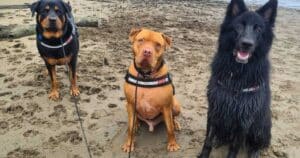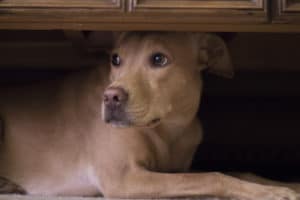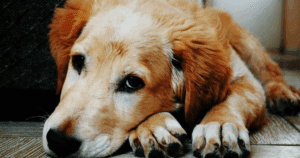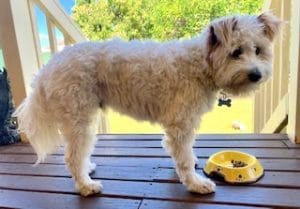
One of the most common dog behaviour issues I am asked by dog owners is how to stop a dog jumping up on people.
This dog behaviour issue usually starts from when they are a puppy as they naturally try to get closer to people’s hands and faces a they recognise these as a source of human affection.
We also tend to reinforce a puppy jumping up constantly as it seems cute and fun when they are puppies, however problems develop when this behaviour continues in adult dogs, so teaching young puppies not to jump and other unwanted behaviour such as biting and chewing from the first day you bring them home can help prevent this.
However, in adult dogs it is still often reinforced constantly by us and other people. As well as being a nuisance, a jumping dog can be a risk to the elderly and small children who may be knocked over.
There are a number of reasons why dogs jump. Firstly, jumping for a puppy is a survival technique, an instinct from ancestral times when a wolf pup would jump at the mouth of an adult in order to get them to regurgitate food. Whilst they don’t rely on this anymore, that tendency still exist and, as mentioned before, is a behaviour that tends to get rewarded and reinforced time and time again in puppies and then adult dogs.
Other reasons for a dog jumping up on you and others includes simple excitement or attention seeking behaviour. Other attention seeking behaviour that your dog might display include mouthing, barking, nudging for pats or scratching at the back door to get your attention – and which they are often very successful at.
Even if you tell your dog to get down or push them down, you are rewarding and therefore reinforcing the jumping. How can this be? Well, think about it. If their primary aim when jumping up is to get your or others attention by jumping, then as soon as you give them even the smallest response, you are giving them exactly what they want at that time – your attention! Giving a dog what it wants at the time they are displaying an attention seeking behaviour = a reward = behaviour reinforced.
First, you need to make sure that you eliminate any reinforcement of the jumping. This means you need to ignore the behaviour, turn your back, keep your arms folded, no eye contact, no verbal response and step out of the way so they can’t make contact. As soon the puppy or dog stops and has all four paws on the ground, then you mark that behaviour with a ‘yes’ and reward your dog for the desired behaviour that you want. You could then start to place a cue word on that action ie: ‘yes’ ‘no jump’ when they are down, and reward that desired behaviour, so they start to associate ‘no jump’ with the action you want and a reward (which could be a praise…or even giving them what they want…a pat!)
If you have an older dog that already always jumps up on you when you walk in the door or on other people, you can teach and then give them an alternative command when they would normally jump such as ‘sit’ or ‘on your mat’ instead to stop the jumping in it tracks.
If the urge to jump up is irresistible to your dog, it may be necessary to set up specific training sessions. To do this, put him on a short leash and get a friend to walk slowly toward you.
When your dog is sitting obediently or has all four paws on the ground, your friend can approach and give them praise, but must move away again if they get over excited and jump up. Again, this is because you want to make sure you and others reward the desired behaviour/action and not reward/reinforce the unwanted action of jumping.
As training progresses, you should be able to take off the leash, but your dog will still need to be reminded to sit. Make sure that everyone enforces your rule and you are consistently doing this every time you get home or someone comes to your door, or your training will fail. Consistency is key!!!
Do not become complacent about praising your dog for sitting obediently and not jumping or they are likely to start jumping again as a way to get your attention. They key is rewarding the desired behaviour and avoid unknowingly rewarding unwanted behaviour.
These are just a few ideas and it can be hard to understand how you are reinforcing the behaviour. So if you need some help, visit the NDTF website to Find a Trainer near you.
About the Author: Lara Shannon is co-Host of Pooches at Play and has completed a Certificate III in Dog Behaviour & Training with the National Dog Trainers Federation. Lara also runs her own dog walking, dog minding and dog training business in Melbourne’s Bayside area and Author of Eat, Play, Love (Your Dog).

Poor gut health and dog behaviour issues


How to deal with excessive barking in dogs

Treating Noise Phobia in dogs and cats



Get your paws on Lara Shannon’s best selling books ‘Eat, Play, Love (your dog) and World of Dogs.
Available in Australia, USA, UK and Canada.